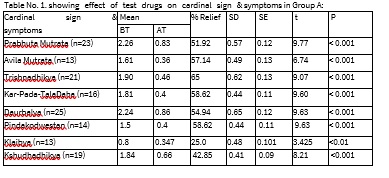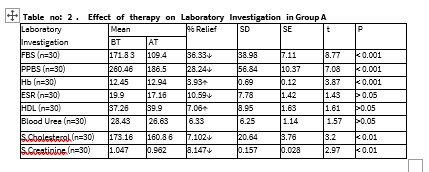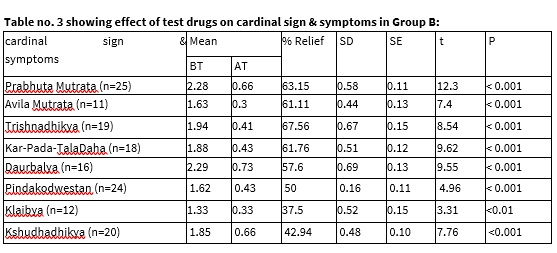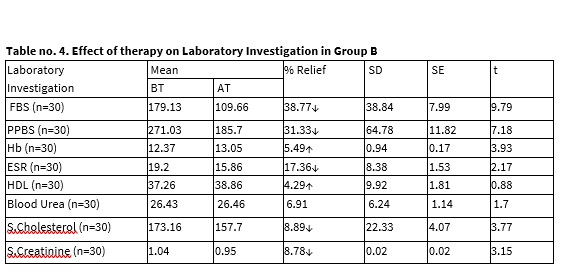Original Article
Year: 2020 |Volume: 1 | Issue: 6 |Pages: 230-236
CLINICAL STUDY OF SALSARADI GANA BHAWIT (THREE TIMES) SHILAJATU IN THE MANAGEMENT OF MADHUMEHA.
About Author
Correspondence Address:
Dr Munna Kumar M D (Ayu), Department of Rasa Shastra govt. Ayurvedic College & Hospital Patna (Bihar). India Email id- drmunnakr1@gmail.com
Date of Acceptance: 2020-09-25
Date of Publication:2020-10-01
Article-ID:IJIM_31_10_20 http://ijim.co.in
Source of Support: NIL
Conflict of Interest: NIL
How To Cite This Article: Munna Kumar, et.al. Clinical study of Salsaradi Gana bhawit (three times) Shilajatu in the management of Madumeha.. Int. J Ind. Med. 2020;1(6):230-236.
Abstract
Recent researches on Shilajatu have revealed that it is a vegetative product rather than a mineral product. Various acharyas has mentioned that Shilajatu having bhawana ofSalsaradi Gana is Madhumeha-hara properties. Hence study is planned to evaluate effect of Salsaradi Gana bhawit Shilajatu (three times) with and without Salsaradi Gana Anupana in the management of Madhumeha for that 60 Patients having classical symptomatology of Madhumeha have been selected from the O.P.D. of Govt. Ayurvedic College & Hospital, Patna (Bihar) and divided in two groups. Results of study shows that Salsaradi Gana bhavita shilajeet significantly decreased blood glucose level in diabetic patient in both groups. According to study Salsaradi Gana bhavita Shilajeet with Anupana of Salsaradi Gana has better results.
Keywords: Salsaradi Gana, Shilajatu, Madhumeha
Introduction
Prameha, greatest amongst Anushangi (relapsing) diseases, is increasing day by day. Madhumeha, is a Tridosha predominant Vyadhi,1 it is a type of Vataja Prameha and according to modern symptoms of diabetes mellitus like polyurea, polydipsia, etc. are very similar to it.2 Classics have mentioned two types of pathophysiologies viz. Dhatukshayaja and Avaranajanya.3 Both of these cause Vata-Prakopa. This provoked Vata carries Oja to the Basti. Along with this, vitiation of various body elements likes Meda, Mamsa, Kleda, Vasa and Lasika occurs, which causes various symptoms and signs.4 In Madhumeha the treatment should be aimed at Kapha-Meda-Harana (decrease Kapha, Meda) and Vatashamana. The type II-Diabetes mellitus patients are usually obese, suffer from it in their 40’s and can be managed easily by hypoglycaemic drugs. Type II Diabetes mellitus can be correlated with Avaranajanya Madhumeha while type I-Diabetes mellitus may be Dhatuapakarshanajanya. Acharya Sushruta has mainly described Salsaradi Gana in sutra sthana 37th chapter. Here he has given a list of 23 plants whichmakes the Salsaradi Gana. Describing the properties of this Gana, he says that Salsaradi Gana possesses Kapha and Medoshoshana properties and useful in Kushtha (skin disease), Prameha (diabetes)and Pandu rog (anaemia ).5 Shilajeet is a Tridosha Shamaka, balya, Rasayana drug, and specially work on Mutravaha, Shukravaha and Medovaha Strotas.6 It is having Deepana, Pachana, Anulomana, Kledahara properties. Thus it becomes commonly used in the Kapha, Pitta stage of Samprapti of madhumeha where there is Kleda Vriddhi.
Aims and Objectives
To evaluate the effect of Salsaradi Gana bhawit Shilajatu (three times) without Salsaradi Gana Anupana and Salsaradi Gana bhawit Shilajatu (three times) with Salsaradi Gana Anupana in the management of Madhumeha.
Plan of study
Criteria for selection of patients:
- 60 Patients having classical symptomatology of Madhumeha have been selected from the O.P.D. of Govt. Ayurvedic College & Hospital, Patna (Bihar).
- Age group of patients was between 30 to80 years.
- Patients having fasting blood sugar level ≥ 126 mg/dl or OGTT (2- hours after 75gm oral glucose load) level ≥ 200 mg/dl up to 600 mg/dl. A detailed clinical Performa has been prepared incorporating selected symptoms. Haematological and Biochemical investigations were carried out.
Criteria for Exclusion of Patients:
- All patients of diabetes mellitus receiving insulin.
- Patients having chronic complications of diabetes mellitus like
- Micro vascular: Retinopathy, Neuropathy & Nephropathy.
- Macro vascular: Coronary Artery Disease, Peripheral vascular disease & Cerebrovascular disease.
Grouping
|
Group |
Group A |
Group B |
|
Drug |
Salsaradi Gana bhawit Shilajatu without Salsaradi Gana Anupana |
Salsaradi Gana bhawit Shilajatu with Salsaradi Gana Anupana |
|
No. of patients |
30 patients |
30 patients |
|
Dose |
500 mg BD |
500 mg BD |
|
Duration |
90 days |
90 days |
|
Follow-up |
15 days |
15 days |
Criteria for assessment:
The results of the therapy were assessed after completion of treatment on Improvement in the signs and symptoms based on both Ayurvedic and
Modern parameters.
Investigations conducted before and after treatment. The changes observed in the signs and symptoms were assessed by adopting suitable scoring pattern and the objective signs by using appropriate clinical tools. The detail assessment of clinical signs and symptoms are discussed below:
1) Prabhuta Mutrata (Polyuria):
Quantity of urine
• 1.50 to 2.00 liters / 24 hrs. - 0
• > 2.00 to 2.50 liters / 24 hrs. - 1
• >2.50 to 3.00 liters / 24 hrs. - 2
• >3.00 liters / 24 hrs. - 3
2) Trishna - Adhika (Polydipsia)
• Feeling of thirst 7 – 9 times/24 hr, either/or Intake of – 0 water 5 –7 times/24 hr with quantity 1.5 – 2.0 lit. /24 hr
• Feeling of thirst 9 - 11 times/24 hr, either/or Intake of – 1 water 7 – 9 times/24 hr with quantity 2.0 - 2.50 liter/24 hr
• Feeling of thirst 11–13 times/24 hr, either/or Intake of – 2 water 9-11 times/24 hr with quantity 2.50 -3.00 liter/24 hr
• Feeling of thirst >13 times/24 hr, either/or Intake of – 3 water >11 times/24 hours with quantity >3.00 litre/24 hr
3) Avila Mutrata (Turbidity in urine)
• Crystal clear urine - 0
• Faintly cloudy or hazy with slight turbidity. – 1
• Turbidity clearly present and newspaper easily read through test tube - 2
• Newspaper not easily read through test tube - 3
•Newspaper cannot be visualized through test tube - 4
4) Kshudhadikya (Polyphagia)
• Feeling of kshudha3-4 times/24 hr, either/or Intake of food 2-3 times/24 hr - 0
• Feeling of kshudha5-6 times/24 hr, either/or Intake of food 4-5 times/24 hr - 1
• Feeling of kshudha7-8 times/24 hr, either/or Intake of food 6-7 times/24 hr - 2
• Feeling of kshudha9-10 times/24 hr,either/or Intake of food 8-9 times/24 hr - 3
5) Kara –Pada Tala Daha
• No Daha - 0
• Kara-Pada tala Daha incontinuous - 1
• kara-Pada tala Daha continuous but bearable & not severe - 2
• kara-Pada tala Daha continuous and severe & Unbearable - 3
6) Daurbalya (Weakness)
• Can do routine exercise/work - 0
• Can do moderate exercise with hesitancy - 1
• Can do mild exercise only, with difficulty - 2
• Cannot do mild exercise too - 3
7) Klaibya (Libido)
• Normal - 0
• Decreased frequency with normal performance - 1
• Decrease frequency with insufficiency – 2
• No sexual stimulation at all - 3
8) Pindikodveshtana (Cramps)
• No cramps - 0
• Cramps after walking more than 1 km - 1
• Cramps after walking ½ km - 2
• Inability in walking even ½ km – 3.
Statistical analysis:
Mean, percentage relief, S.D., S.E., ‘t’ and ‘p’ values were calculated. The obtained data were analyzed statistically. The observed difference was calculated by adopting student ‘t’ test.

table 1

table 2

table 3

table 4
Observations and results:
In Group A, reveals that test drug provided statistically highly significant relief in Prabhuta Mutrata by 51.92% with‘t’ value 9.77, (p< 0.001). Table reveals that test drug provided relief in Avila Mutrata by 57.14%, ‘t’ value 6.74, (p<0.001) which was statistically highly significant.
Test drug provided statistically highly significant relief in Trishnadhikya (Polydipsia) by 65%,‘t’ value of 9.07, (p< 0.001). Table shows highly significant relief in Kara-Pada-Tala Daha by 58.62% ‘t’ value of 9.60, (p<0.001). Table reveals that test drug provided statistically highly significant relief in Darbalya by 54.94% with‘t’ value 9.63, (p< 0.001). Table reveals that test drug provided statistically highly significant relief in Pindkodwestana by 42.85% with‘t’ value 4.83, (p< 0.001). Table reveals that test drug provided statistically significant relief in Klaibya by 25.0% with‘t’ value 3.425, (p< 0.01). Test drug provided statistically highly significant relief in Kshudadhikya (Polyphagia) by 42.85%, ‘t’ value of 8.21, (p< 0.001).
The mean grade of fasting blood sugar before treatment was 171.83, it becomes 109.4 after therapy with S.D± 38.98 giving a change (decrease) of 36.33% with ‘t’ value of 8.77 (< 0.001) which was statistically highly significant. The mean grade of post parandial blood sugar before treatment was 260.46, it becomes 186.5 after therapy with S.D± 56.84giving a change (decrease) of 28.24% with ‘t’ value of 7.08 (< 0.001) which was statistically highly significant.
In Group BTable, reveals that test drug provided statistically highly significant relief in Prabhuta Mutrata by 63.15% with‘t’ value 12.34, (p< 0.001). Table reveals that test drug provided relief in Avila Mutrata by 61.11%, ‘t’ value 7.4, (p< 0.001) which was statistically highly significant. Test drug provided statistically highly significant relief in Trishnadhikya (Polydipsia) by 67.56%,‘t’ value of 8.54, (p< 0.001). Table shows highly significant relief in Kara-Pada-Tala Daha by 61.76% ‘t’ value of 9.62, (p<0.001). Table reveals that test drug provided statistically highly significant relief in Darbalya by 57.6% with‘t’ value 9.55, (p< 0.001). Table reveals that test drug provided statistically highly significant relief in Pindkodwestana by 50% with‘t’ value 4.96, (p< 0.001). Table reveals that test drug provided statistically significant relief in Klaibya by 37.5% with‘t’ value 3.31, (p< 0.01). Test drug provided statistically highly significant relief in Kshudadhikya (Polyphagia) by 45.94%,‘t’ value of 7.76, (p< 0.001).
The mean grade of fasting blood sugar before treatment was 179.13, it becomes 109.66 after therapy with S.D± 38.77 giving a change (decrease) of 38.77% with ‘t’ value of 9.79 (< 0.001) which was statistically highly significant. The mean grade of post parandial blood sugar before treatment was 271.03, it becomes 185.7 after therapy with S.D± 64.78giving a change (decrease) of 31..33% with ‘t’ value of 7.18 (< 0.001) which was statistically highly significant.
Discussion
In the study this was observed that relief in the symptom Prabhuta Mutrata (Polyuria), Avila Mutrata (Turbidity in urine), Trishna - Adhika (Polydipsia), Kshudhadikya (Polyphagia), kara –Pada Tal Daha, Daurbalya (Weakness) and Pindikodveshtana (Cramps) was statistically highly significant having percentage relief about 51.92%, 57.14%, 65%, 58.62%, 54.94%, 42.85%, 25.0%, and 42.85% in Group-A and 63.15%, 61.11%, 67.56%, 61.76%, 57.6%, 50%, 37.5%, and 45.94% in Group-B respectively. Relief in symptom Klaibya was statistically significant having percentage relief about 25% in Group-A and 37.5% in Group-B. Prabhuta Avila Mutrata which was increases due to the Kaphaprakopa which leads to Kledavrudhi throughout the body was reduced due to Vikruta Kleda Nirgamana through urine, Kledashoshsna & Kapha- Vata shaman action of Shilajeet & salsaradigana. Due to improper metabolism Meda Dhatu and Agni vikriti which leads to Kshudhadhikya, Trishnadhikya, reduced markedly due to Medohara and Agnivrudhi action of Shilajeet & Salsaradi gana. Tridoshaprakopa in body i.e. Pittaprakopa leads to Karapadataladaha, reduced markedly due to Tridoshaghna action of Shilajeet. As in Madhumeha there is Saptadhatukshaya due to Vatavrudhi and Tridoshaprakopa leads to Daurbalya, Pindikodweshtana were reduced markedly may be due to dhatuvardhana and Rasayana properties of Shilajeet. The plant present in Salasadi Gana, mainly has kashaya & tikta rasa, Ruksha & laghu guna and katu vipaka. Beside this fact Salsaradi Gana is used as mehahara and kapha-medohara by various acharyas. Shilajeet is indicative of a potent medicine used for Rasa and Medadhatu gat Vikara especially for prameha and sthaulya, because of its has Tikta Rasa, Katu Vipaka, Ushna Virya, Shoshak and Chhedak properties. Due to these properties Salsaradi gana Bhavit Shilajatu works in both types of Madhumeha i.e. Dhatukshayaja and Avaranajanya.
Conclusion
Present study shows that Salsaradi Gana bhavita shilajeet significantly decreased blood glucose level in diabetic patient. According to study Salsaradi Gana bhavita shilajeet has better efficacy on symptoms of Prabhuta Mutrata, Avila Mutrata, Trishnadhikya, Kar-Pada-Tala Daha, Daurbalya, Pindakodwestan, Klaibya and Kshudhadhikya. Observing effect on lab. Investigations, maximum change was found in Fasting Blood Sugar (FBS), Post Parandial Blood Sugar (PPBS). The significant difference between the improvements in Group B in comparison with Group A is due to the Anupan of Salsaradi Gana kwatha.
References
value="
- Y.T. Acharya, editor, Charaka Samhita Chikitsasthana, Chapter 6, Sutra 8, Chakrapani commentary Chaukhamba Orientalia, Varanasi, 2007, p.445
- Ramachandran, A. "Know the signs and symptoms of diabetes." The Indian journal of medical research 140.5 (2014): 579.
- Pandit Kashinath shastri, editor; Charak Samhita Chikitsa sthan Vatavyadhi chi.28/15,Vol.2, Chaukhamba Bharati Academy, Varanasi;Reprinted, 2001; 780
- Pandit Kashinath shastri, editor; Charak Samhita Chikitsa sthan Vatavyadhi chi.28/18-19,Vol.2, Chaukhamba Bharati Academy, Varanasi;Reprinted, 2001; 780
- ambikadutta Shastri (2014). Sushrut Samhita of Acharya Sushruta, part 1 Sutrasthana Dravyasangrahaniya addhyaya 38/12-13, published by Chaukhambha Sanskrit Sansthan, Varanasi, P. 183
- Shukla V, editor, (2nd ed.). Charaka Samhita of charak, Chikitsa sthan: Chapter 1-3, Verse 51. Varanasi: Chowkhambha Sanskrit Series, 2002; 27.
"
"

